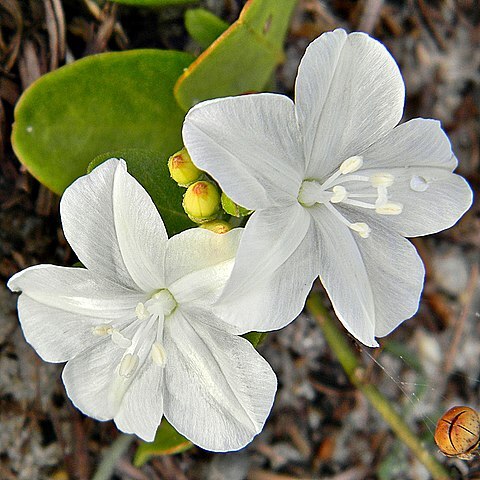Herbs or woody twiners, rarely erect, hairs usually stellate, rarely glabrous. Leaves petiolate, often cordate, margin entire, rarely dentate or lobed. Inflorescences axillary, often umbelliform or capitate cymes, less often scorpioid cymes, dense terminal spikes, or capitula, or solitary flowers; bracts linear, subulate (in China), or leaflike. Sepals equal or outer 3 often larger. Corolla blue, lilac, or pink, rarely white, funnelform or campanulate, with 5 distinct midpetaline bands; limb 5-toothed or subentire. Stamens included; filaments adnate to corolla basally; anthers ellipsoid; pollen globose, usually 5-zonocolpate, not spiny. Disc small or absent. Pistil included; ovary 2-loculed; ovules 2 per locule. Style 1, filiform; stigmas 2, elliptic or oblong, flat, rarely linear or globose. Capsule globose, 4-or 8-valved. Seeds 4 or fewer, smooth or minutely papillate, glabrous or velutinous, abaxial edges often with a narrow scarious wing.
Herbs or suffrutescent procumbent shrubs, glabrous or densely pubescent. Leaves petiolate, mostly cordate at the base, entire, dentate or lobate. Flowers axillary, solitary in scorpioid cymes or in umbelliform or head-like cymes; small or medium-sized; the bracts small and linear to lanceolate or large and foliose; sepals 5, equal or unequal; corolla campanulate or funnelform, blue, lilac, or white (red in one species), deeply lobed, 5-dentate or almost entire; stamens and style included (exserted in one species), the pollen pantocolpate; style one, fili-form, the 2 stigmas ellipsoid or oblong and complanate, ovary 2-locular, 4-ovulate, the disc small or none. Fruits capsular, globose to subglobose, 2-celled, with 4 or rarely 8 valves, 4-seeded; seeds glabrous, tuberculate, winged or pilose.
Twining or prostrate herbs or shrubs, rarely erect, mostly hairy (often stellately in extra-African forms). Flowers in axillary, usually peduncled cymes, or capitate or solitary; inflorescences usually bracteate. Sepals 5, equal or unequal with the 2 outer ones often large. Corolla funnel-shaped,obscurely lobed. Stamens and style included. Ovary 2-locular, 4-ovuled; style simple, filiform; stigmas 2, elliptic or oblong, rarely globose or filiform. Capsule globose, 2-locular, 4-seeded. This genus is very close to Convolvulus and there is no universal distinguishing character. Since however the species are mostly extra-African it would not be wise to sink the genus after study of only a few species.
Flowers in axillary usually pedunculate cymes, or capitate or solitary; bracteoles small, linear to lanceolate or the outer ones larger, foliaceous; pedicels very short or flowers sessile.
Ovary bilocular, 4-ovuled; style simple, filiform, included; stigmas 2, elliptic or oblong, more or less flattened, rarely globose or filiform.
Corolla small to medium-sized, funnel-shaped or campanulate, blue, mauve or pink, rarely white, obscurely 5-lobed; midpetaline areas distinct.
Herbaceous to woody twining or prostrate herbs or shrubs, rarely erect, mostly hairy, with 2–3-armed hairs.
Stamens included; filaments linear; anthers oblong; pollen smooth.
Sepals 5, equal or unequal with the 2 outer ones often large.
Capsule globose, bilocular, 4-seeded or less by abortion.
Leaves variable, entire often cordate at the base.
Inflorescences usually bracteate.
Seeds usually glabrous.
Disk small or absent.

